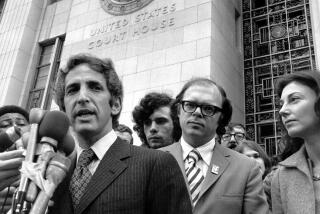Osama bin Laden’s journal contains his thoughts on killing Americans
Osama bin Laden kept a personal journal in which he contemplated how to kill as many Americans as possible, including in terrorist attacks against Los Angeles, Chicago and Washington, according to U.S. officials.
The handwritten journal was part of a vast cache of digital and printed material hauled away from Bin Laden’s hide-out after U.S. Navy SEALs killed him last week in Abbottabad, Pakistan.
One official said Wednesday that the trove provided “terabytes” of new information about Al Qaeda.
The official described the journal as full of planning ideas and outlines of potential operations — “aspirational guidance” on how to kill the maximum number of people rather than specific proposals or plots that were actually underway.
In one passage, Bin Laden wondered how many Americans would have to die in U.S. cities to force the U.S. government to withdraw from the Arab world. He concluded that it would require another mass murder on the scale of the Sept. 11 attacks to spur a reversal in U.S. policy, an official said.
The officials declined to provide details about potential plots in Los Angeles and Chicago. Bin Laden discussed an operation in Washington, one official said, “because of its iconic value.”
Michael Downing, commanding officer of the Los Angeles Police Department’s counter-terrorism and special operations bureau, said the intelligence cache confirms what authorities have long known: “Los Angeles was on the target list for Al Qaeda.”
In 1999, an Al Qaeda-trained terrorist, “millennium bomber” Ahmed Ressam, was arrested in Port Angeles, Wash., with a carload of explosives. He was convicted of plotting to bomb Los Angeles International Airport.
A CIA-led multiagency task force continues to scrutinize data from five computers, dozens of flash-drive storage devices and other items taken from Bin Laden’s walled compound. The analysts have not found evidence of an imminent threat of attack by Al Qaeda or its affiliates around the globe, officials said.
But the initial analysis has shown that Bin Laden was in regular communication with several deputies, including reputed operations chief Atiyah Abd Rahman, officials said. The messages were sent primarily by couriers carrying flash drives, the official said.
Some reports have said Rahman was killed in a 2010 drone strike, but U.S. officials say they believe he is still alive.
The intelligence cache has also upended the long-held belief that Bin Laden was an isolated, inspirational figurehead who had cut off communications and played no operational role in attacks or plots, according to the officials, who spoke on condition of anonymity because they are not authorized to publicly discuss sensitive intelligence information.
“These assumptions [are] going out the window,” one official said.
Discovery of the journal was not entirely unexpected. Bin Laden’s son Omar described his father in a 2009 memoir, “Growing Up Bin Laden,” as regularly recording his thoughts and plans.
The son sharply criticizes his father’s terrorist operations in the book, but this week he accused the Obama administration of murdering his father instead of capturing him. “We maintain that arbitrary killing is not a solution to political problems,” he said in a statement released to several news organizations.
Intelligence officials throughout the U.S. government have been briefed daily this week on new information gleaned from the intelligence haul, one official said.
The messages to Rahman, a Libyan in his mid-30s, are of particular interest.
Rahman joined Bin Laden in Afghanistan as a teenager in the 1980s and “since then, he has gained considerable stature in al-Qaeda as an explosives expert and Islamic scholar,” according to a State Department website that offers a $1-million reward for information leading to him.
In 2005, Rahman signed a letter to Abu Musab Zarqawi, the now-dead leader of the group Al Qaeda in Iraq, rebuking the group for indiscriminate violence against Shiite Muslims, according to counter-terrorism experts. Rahman met Zarqawi in Herat, in western Afghanistan, in the late 1990s, according to the State Department dossier.
Rahman is now believed to be in Pakistan, U.S. officials said.
Also Wednesday, several members of Congress and other officials got a chance to examine photos of Bin Laden’s corpse. President Obama has decided not to release the photos publicly. Bin Laden was shot in the head and chest and was buried at sea.
“By viewing these photos, I can help dispel conspiracy theorists who doubt that Bin Laden is in fact dead,” said Sen. James M. Inhofe (R-Okla.), who was among those who traveled to CIA headquarters in Langley, Va., to see the photos.
Times staff writers David S. Cloud in Washington and Andrew Blankstein in Los Angeles contributed to this report.
More to Read
Sign up for Essential California
The most important California stories and recommendations in your inbox every morning.
You may occasionally receive promotional content from the Los Angeles Times.












